Abstract
Soluble c-type cytochromes are central to metabolism of C1 compounds in methylotrophic bacteria. In order to characterize the role of c-type cytochromes in methane-utilizing bacteria (methanotrophs), we have purified four different cytochromes, cytochromes c-554, c-553, c-552, and c-551, from the marine methanotroph Methylomonas sp. strain A4. The two major species, cytochromes c-554 and c-552, were monoheme cytochromes and accounted for 57 and 26%, respectively, of the soluble c-heme. The approximate molecular masses were 8,500 daltons (Da) (cytochrome c-554) and 14,000 Da (cytochrome c-552), and the isoelectric points were pH 6.4 and 4.7, respectively. Two possible diheme c-type cytochromes were also isolated in lesser amounts from Methylomonas sp. strain A4, cytochromes c-551 and c-553. These were 16,500 and 34,000 Da, respectively, and had isoelectric points at pH 4.75 and 4.8, respectively. Cytochrome c-551 accounted for 9% of the soluble c-heme, and cytochrome c-553 accounted for 8%. All four cytochromes differed in their oxidized versus reduced absorption maxima and their extinction coefficients. In addition, cytochromes c-554, c-552, and c-551 were shown to have different electron paramagnetic spectra and N-terminal amino acid sequences. None of the cytochromes showed significant activity with purified methanol dehydrogenase in vitro, but our data suggested that cytochrome c-552 is probably the in vivo electron acceptor for the methanol dehydrogenase.
Full text
PDF
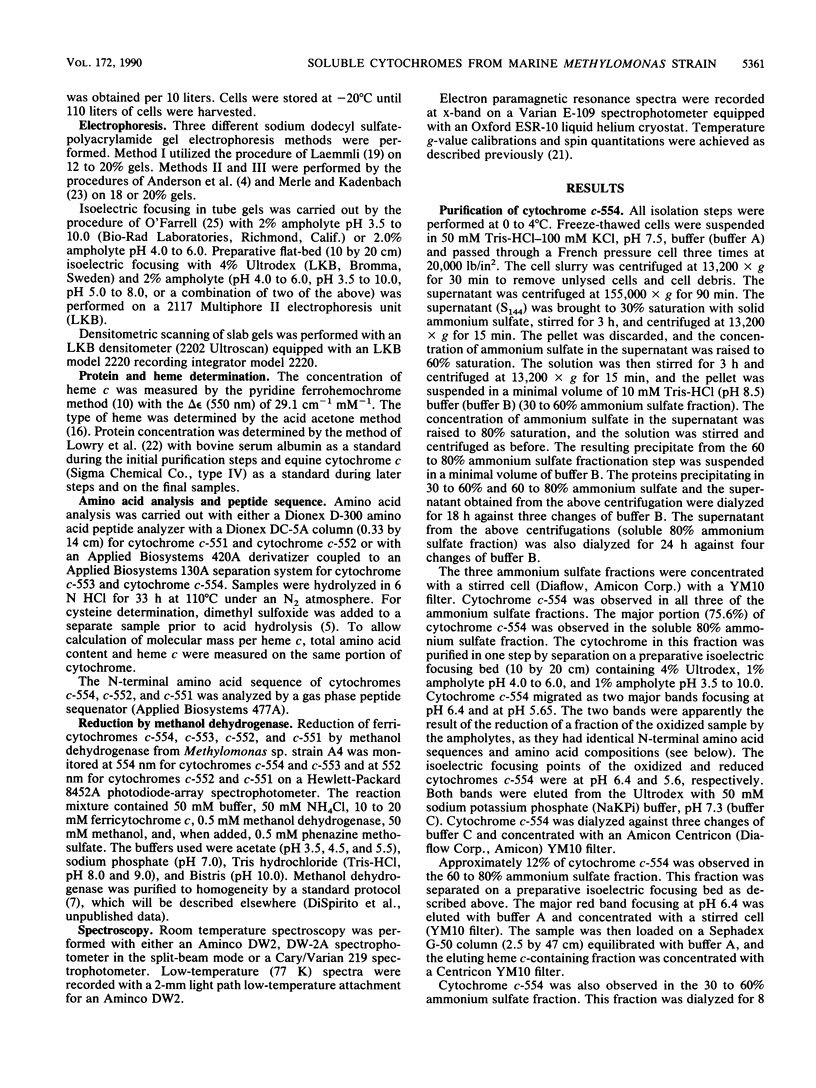
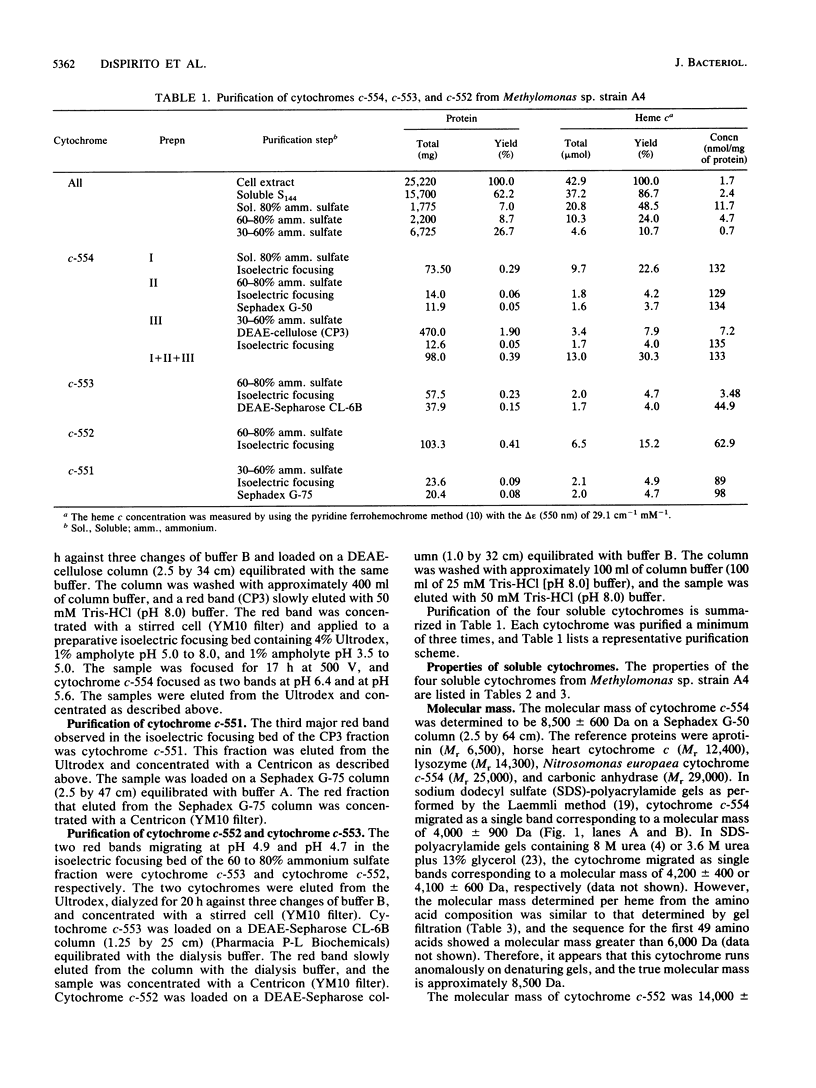
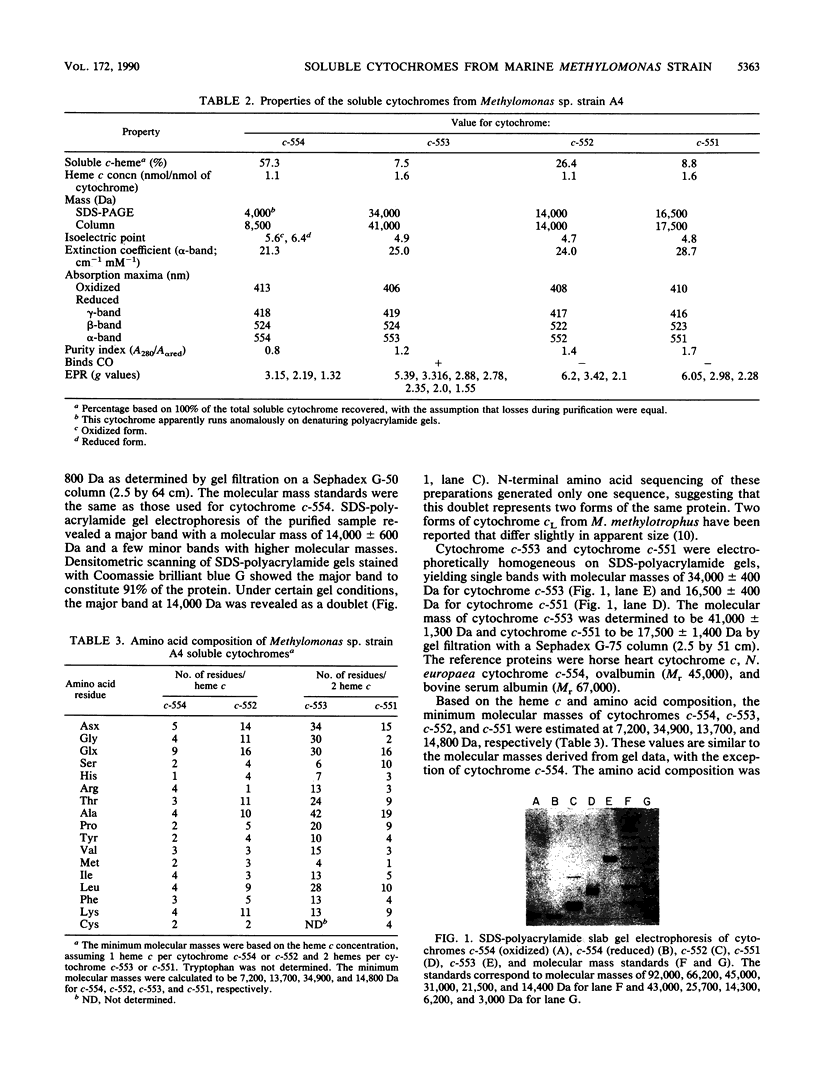
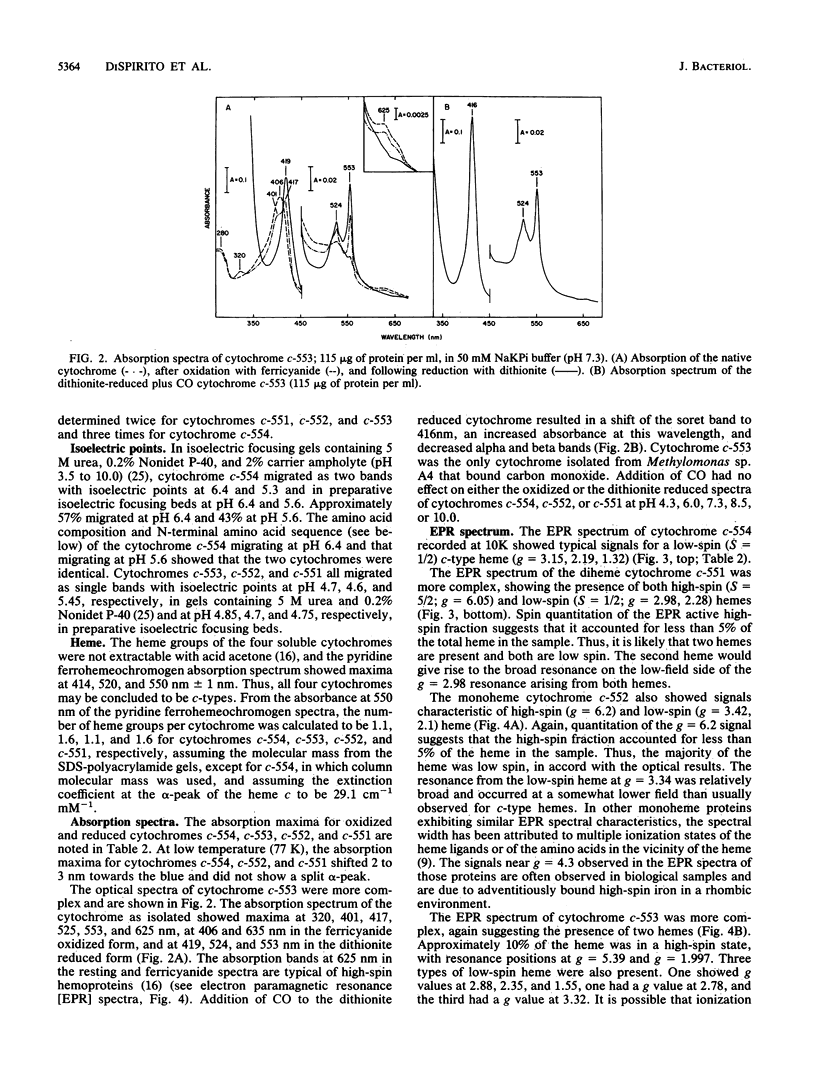
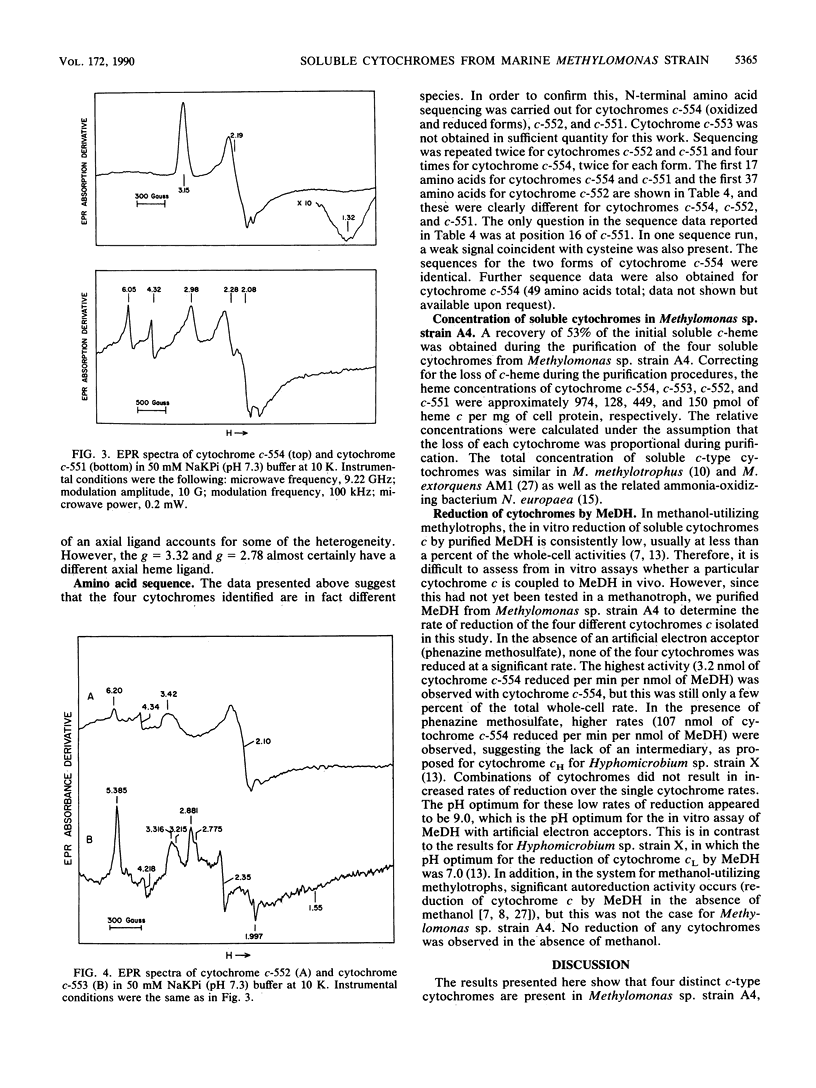
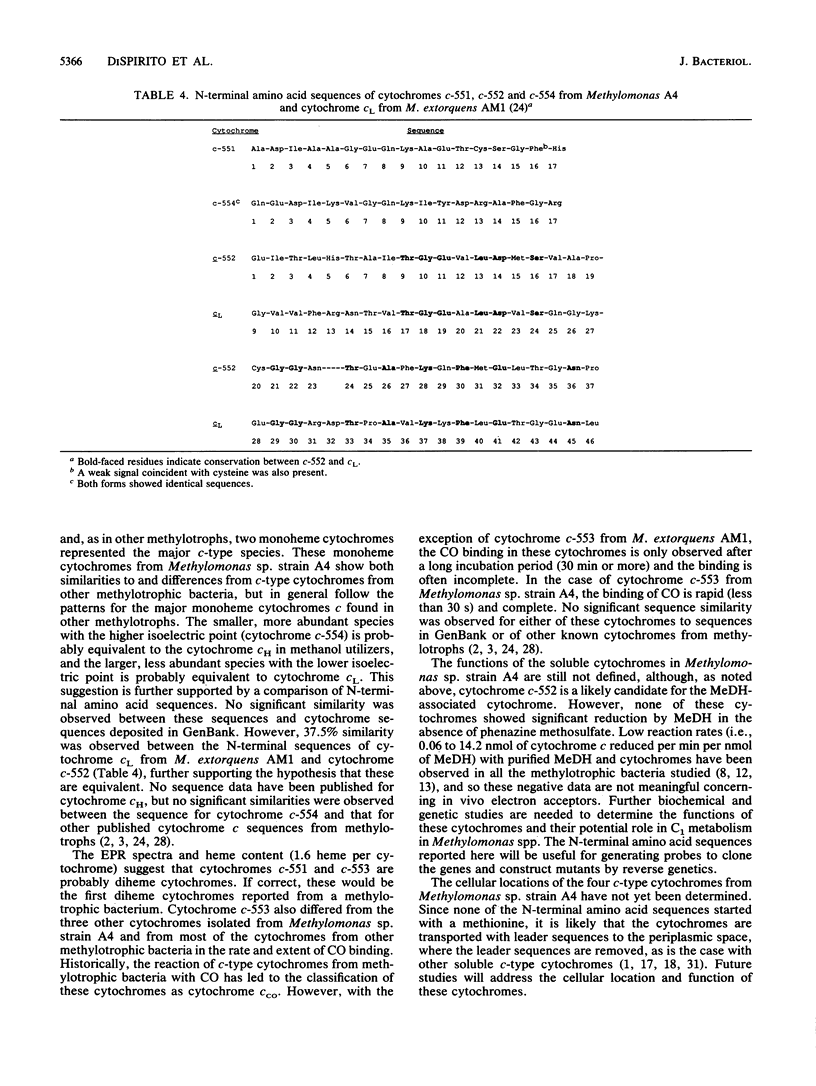
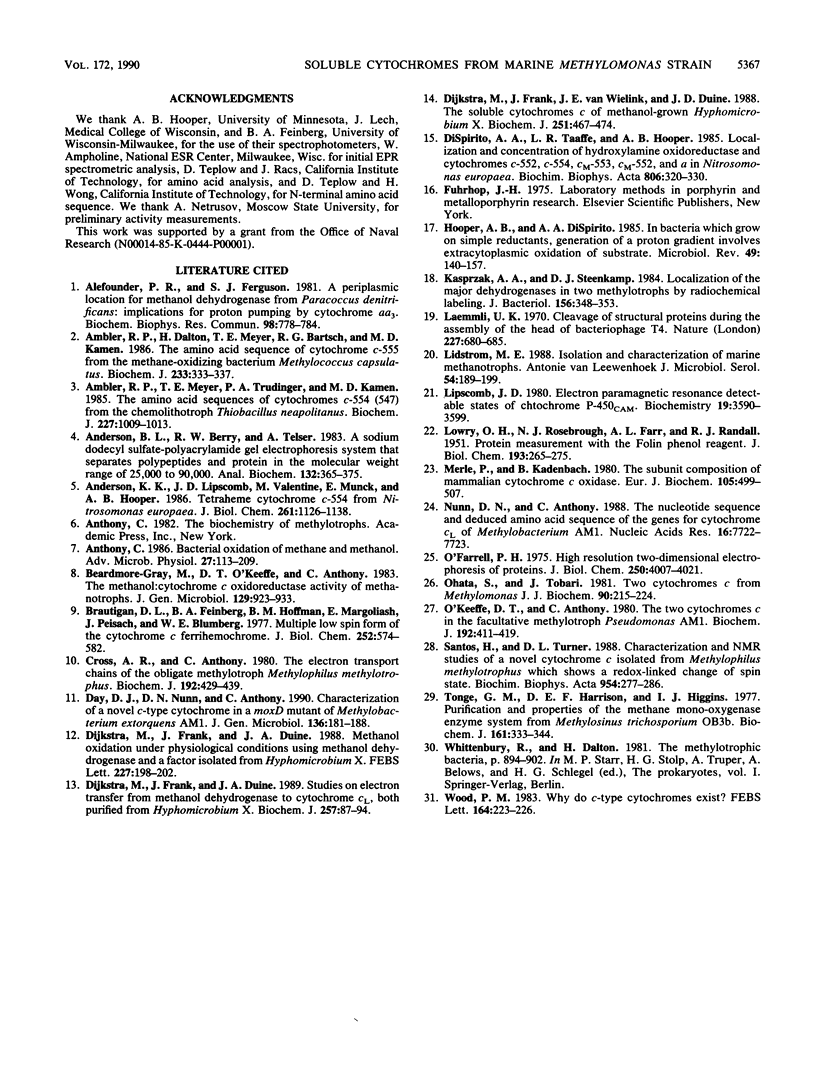
Images in this article
Selected References
These references are in PubMed. This may not be the complete list of references from this article.
- Alefounder P. R., Ferguson S. J. A periplasmic location for methanol dehydrogenase from Paracoccus denitrificans: implications for proton pumping by cytochrome aa3. Biochem Biophys Res Commun. 1981 Feb 12;98(3):778–784. doi: 10.1016/0006-291x(81)91179-7. [DOI] [PubMed] [Google Scholar]
- Ambler R. P., Dalton H., Meyer T. E., Bartsch R. G., Kamen M. D. The amino acid sequence of cytochrome c-555 from the methane-oxidizing bacterium Methylococcus capsulatus. Biochem J. 1986 Jan 15;233(2):333–337. doi: 10.1042/bj2330333. [DOI] [PMC free article] [PubMed] [Google Scholar]
- Ambler R. P., Meyer T. E., Trudinger P. A., Kamen M. D. The amino acid sequence of the cytochrome c-554(547) from the chemolithotrophic bacterium Thiobacillus neapolitanus. Biochem J. 1985 May 1;227(3):1009–1013. doi: 10.1042/bj2271009. [DOI] [PMC free article] [PubMed] [Google Scholar]
- Anderson B. L., Berry R. W., Telser A. A sodium dodecyl sulfate--polyacrylamide gel electrophoresis system that separates peptides and proteins in the molecular weight range of 2500 to 90,000. Anal Biochem. 1983 Jul 15;132(2):365–375. doi: 10.1016/0003-2697(83)90022-2. [DOI] [PubMed] [Google Scholar]
- Andersson K. K., Lipscomb J. D., Valentine M., Münck E., Hooper A. B. Tetraheme cytochrome c-554 from Nitrosomonas europaea. Heme-heme interactions and ligand binding. J Biol Chem. 1986 Jan 25;261(3):1126–1138. [PubMed] [Google Scholar]
- Anthony C. Bacterial oxidation of methane and methanol. Adv Microb Physiol. 1986;27:113–210. doi: 10.1016/s0065-2911(08)60305-7. [DOI] [PubMed] [Google Scholar]
- Brautigan D. L., Feinberg B. A., Hoffman B. M., Margoliash E., Preisach J., Blumberg W. E. Multiple low spin forms of the cytochrome c ferrihemochrome. EPR spectra of various eukaryotic and prokaryotic cytochromes c. J Biol Chem. 1977 Jan 25;252(2):574–582. [PubMed] [Google Scholar]
- Cross A. B., Anthony C. The electron-transport chains of the obligate methylotroph Methylophilus methylotrophus. Biochem J. 1980 Nov 15;192(2):429–439. doi: 10.1042/bj1920429. [DOI] [PMC free article] [PubMed] [Google Scholar]
- Day D. J., Nunn D. N., Anthony C. Characterization of a novel soluble c-type cytochrome in a moxD mutant of Methylobacterium extorquens AM1. J Gen Microbiol. 1990 Jan;136(1):181–188. doi: 10.1099/00221287-136-1-181. [DOI] [PubMed] [Google Scholar]
- Dijkstra M., Frank J., Jr, Duine J. A. Studies on electron transfer from methanol dehydrogenase to cytochrome cL, both purified from Hyphomicrobium X. Biochem J. 1989 Jan 1;257(1):87–94. doi: 10.1042/bj2570087. [DOI] [PMC free article] [PubMed] [Google Scholar]
- Dijkstra M., Frank J., Jr, van Wielink J. E., Duine J. A. The soluble cytochromes c of methanol-grown Hyphomicrobium X. Evidence against the involvement of autoreduction in electron-acceptor functioning of cytochrome cL. Biochem J. 1988 Apr 15;251(2):467–474. doi: 10.1042/bj2510467. [DOI] [PMC free article] [PubMed] [Google Scholar]
- Hooper A. B., DiSpirito A. A. In bacteria which grow on simple reductants, generation of a proton gradient involves extracytoplasmic oxidation of substrate. Microbiol Rev. 1985 Jun;49(2):140–157. doi: 10.1128/mr.49.2.140-157.1985. [DOI] [PMC free article] [PubMed] [Google Scholar]
- Kasprzak A. A., Steenkamp D. J. Localization of the major dehydrogenases in two methylotrophs by radiochemical labeling. J Bacteriol. 1983 Oct;156(1):348–353. doi: 10.1128/jb.156.1.348-353.1983. [DOI] [PMC free article] [PubMed] [Google Scholar]
- LOWRY O. H., ROSEBROUGH N. J., FARR A. L., RANDALL R. J. Protein measurement with the Folin phenol reagent. J Biol Chem. 1951 Nov;193(1):265–275. [PubMed] [Google Scholar]
- Laemmli U. K. Cleavage of structural proteins during the assembly of the head of bacteriophage T4. Nature. 1970 Aug 15;227(5259):680–685. doi: 10.1038/227680a0. [DOI] [PubMed] [Google Scholar]
- Lidstrom M. E. Isolation and characterization of marine methanotrophs. Antonie Van Leeuwenhoek. 1988;54(3):189–199. doi: 10.1007/BF00443577. [DOI] [PubMed] [Google Scholar]
- Lipscomb J. D. Electron paramagnetic resonance detectable states of cytochrome P-450cam. Biochemistry. 1980 Jul 22;19(15):3590–3599. doi: 10.1021/bi00556a027. [DOI] [PubMed] [Google Scholar]
- Merle P., Kadenbach B. The subunit composition of mammalian cytochrome c oxidase. Eur J Biochem. 1980 Apr;105(3):499–507. doi: 10.1111/j.1432-1033.1980.tb04525.x. [DOI] [PubMed] [Google Scholar]
- Nunn D. N., Anthony C. The nucleotide sequence and deduced amino acid sequence of the genes for cytochrome cL and a hypothetical second subunit of the methanol dehydrogenase of Methylobacterium AM1. Nucleic Acids Res. 1988 Aug 11;16(15):7722–7722. doi: 10.1093/nar/16.15.7722. [DOI] [PMC free article] [PubMed] [Google Scholar]
- O'Farrell P. H. High resolution two-dimensional electrophoresis of proteins. J Biol Chem. 1975 May 25;250(10):4007–4021. [PMC free article] [PubMed] [Google Scholar]
- O'Keeffe D. T., Anthony C. The two cytochromes c in the facultative methylotroph Pseudomonas am1. Biochem J. 1980 Nov 15;192(2):411–419. doi: 10.1042/bj1920411. [DOI] [PMC free article] [PubMed] [Google Scholar]
- Ohta S., Tobari J. Two cytochromes c of Methylomonas J. J Biochem. 1981 Jul;90(1):215–224. doi: 10.1093/oxfordjournals.jbchem.a133452. [DOI] [PubMed] [Google Scholar]
- Tonge G. M., Harrison D. E., Higgins I. J. Purification and properties of the methane mono-oxygenase enzyme system from Methylosinus trichosporium OB3b. Biochem J. 1977 Feb 1;161(2):333–344. doi: 10.1042/bj1610333. [DOI] [PMC free article] [PubMed] [Google Scholar]
- Wood P. M. Why do c-type cytochromes exist? FEBS Lett. 1983 Dec 12;164(2):223–226. doi: 10.1016/0014-5793(83)80289-0. [DOI] [PubMed] [Google Scholar]



